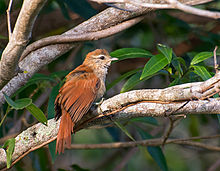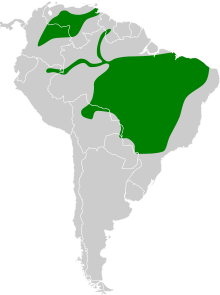Rusty-backed spinetail
| Rusty-backed spinetail | |
|---|---|

| |
| Scientific classification | |
| Domain: | Eukaryota |
| Kingdom: | Animalia |
| Phylum: | Chordata |
| Class: | Aves |
| Order: | Passeriformes |
| Family: | Furnariidae |
| Genus: | Cranioleuca |
| Species: | C. vulpina
|
| Binomial name | |
| Cranioleuca vulpina (Pelzeln, 1856)
| |

| |
| Synonyms | |
|
Cranioleuca dissita Wetmore, 1957 | |
The rusty-backed spinetail (Cranioleuca vulpina) is a
Taxonomy and systematics
The rusty-backed spinetail was
Four subspecies are recognized:[2]
- C. v. apurensis Phelps, WH, 1948
- C. v. vulpina (Pelzeln, 1856)
- C. v. foxi Bond, J & Meyer de Schauensee, 1940
- C. v. reiseri (Reichenberger, 1922)
What are now the Coiba spinetail (C. dissita) and Parker's spinetail (C. vulpecula) were previously treated as subspecies of the rusty-backed spinetail. Other subspecies have been proposed but have not been accepted as valid.[8][9]
Description
The rusty-backed spinetail is 15 to 16 cm (5.9 to 6.3 in) long and weighs 14 to 17 g (0.49 to 0.60 oz). The sexes have the same plumage. Adults of the nominate subspecies C. v. vulpina have a buff
Subspecies C. v. apurensis is the darkest subspecies overall, especially on the crown, wings, and tail. C. v. foxi has darker rufous upperparts than the nominate. C. v. reiseri is paler than the other subspecies but with more rufescent upperparts; its underparts are more buffy than the nominate's and have no streaking.[9][10]
Distribution and habitat
The subspecies of the rusty-backed spinetail are found thus:[9]
- C. v. apurensis: western Venezuela's Apure state
- C. v. vulpina: northeastern Colombia, central and southern Venezuela, western Guyana, northern and central Brazil, extreme eastern Bolivia, and extreme northeastern and eastern Paraguay (but see below)
- C. v. foxi: central Bolivia's Cochabamba Department and possibly Beni Department
- C. v. reiseri: northeastern Brazil
The South American Classification Committee of the American Ornithological Society has only sight records from Guyana and so classes the species as hypothetical in that country.[3]
The rusty-backed spinetail inhabits a variety of landscapes, all of which are on or near water. These include gallery forest, scrub on river islands, thickets along rivers, várzea forest, and shrubby areas around lakes and streams. In elevation it ranges from near sea level to 400 m (1,300 ft).[9][10][11]
Behavior
Movement
The rusty-backed spinetail is a year-round resident throughout its range.[9]
Feeding
The rusty-backed spinetail feeds on
Breeding
The rusty-backed spinetail's breeding season has not been defined but appears to vary geographically. Eggs have been noted in June and July in Venezuela and in November in eastern Brazil. Its nest is a globe of grass, roots, and sticks with its interior lined with bark shreds and lichens. It is often wedged in a low tree or shrub fork above water, where it resembles flood debris. The clutch size is two to three eggs. Nothing else is known about the species' breeding biology.[9]
Vocalization
The rusty-backed spinetail's song has variously been described as "a rapid series of emphatic notes gradually accelerating but fading, lasting c. 2·5–3 seconds, 'ch-ch-ch-chchchchchewewewewewew' "[9], "a series of descending, complaining notes 'scew-scew-scew- -"[10], and a "rattly trill, descending, last 2-3 secs"[11]. Its call is "a soft, nasal, rising 'choy', 'choy-choy' or 'kuee-kweek' ".[9]
Status
The
References
- ^ . Retrieved 13 November 2023.
- ^ Rasmussen, Pamela, eds. (July 2023). "Ovenbirds, woodcreepers". IOC World Bird List. v 13.2. Retrieved July 31, 2023.
- ^ a b Remsen, J. V., Jr., J. I. Areta, E. Bonaccorso, S. Claramunt, G. Del-Rio, A. Jaramillo, D. F. Lane, M. B. Robbins, F. G. Stiles, and K. J. Zimmer. Version 28 September 2023. Species Lists of Birds for South American Countries and Territories. https://www.museum.lsu.edu/~Remsen/SACCCountryLists.htm retrieved October 20, 2023
- ^ von Pelzeln, August (1856). "Neu und wenig gekannte Arten der kaiserlichen ornithologischen Sammlung". Sitzungsberichte der Kaiserlichen Akademie der Wissenschaften. Mathematisch-Naturwissenschaftliche Classe (in German). 20: 153-166 [162].
- ^ Peters, James Lee, ed. (1951). Check-List of Birds of the World. Vol. 7. Cambridge, Massachusetts: Museum of Comparative Zoology. p. 100.
- ISBN 978-1-4081-2501-4.
- Rasmussen, Pamela, eds. (July 2023). "Ovenbirds, woodcreepers". IOC World Bird List Version 13.2. International Ornithologists' Union. Retrieved 6 August 2023.
- ^ Remsen, J. V., Jr., J. I. Areta, E. Bonaccorso, S. Claramunt, G. Del-Rio, A. Jaramillo, D. F. Lane, M. B. Robbins, F. G. Stiles, and K. J. Zimmer. Version 28 September 2023. A classification of the bird species of South America. American Ornithological Society. https://www.museum.lsu.edu/~Remsen/SACCBaseline.htm retrieved October 20, 2023
- ^ a b c d e f g h i j k Remsen, Jr., J. V. and G. M. Kirwan (2020). Rusty-backed Spinetail (Cranioleuca vulpina), version 1.0. In Birds of the World (J. del Hoyo, A. Elliott, J. Sargatal, D. A. Christie, and E. de Juana, Editors). Cornell Lab of Ornithology, Ithaca, NY, USA. https://doi.org/10.2173/bow.rubspi4.01 retrieved November 13, 2023
- ^ ISBN 978-0-19-530155-7.
- ^ ISBN 978-0-9827615-0-2.


